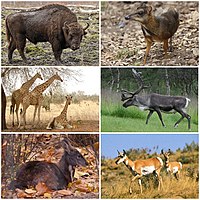
Photo from wikipedia
A large variety of plant species contain condensed tannins and a few of these have been developed as improved varieties for grazing or for feeding as long-stem, chopped or pelleted… Click to show full abstract
A large variety of plant species contain condensed tannins and a few of these have been developed as improved varieties for grazing or for feeding as long-stem, chopped or pelleted hay or as silage. Extracts of tannin-containing plant materials (e.g. quebracho tannin) and tannin-containing by-products of plant materials (e.g. grape marc) have also been fed to livestock. Interactions between livestock and condensed tannins and associated phenolic compounds are complicated and we have much to learn to understand and manage them better. Although many studies have been done on tannin-livestock interactions, many more are needed and especially studies done in conjunction with tannin chemists. Research to date suggests that very few plant materials have ideal condensed tannins for improving the long-term productivity of ruminant livestock (beyond productivity gains from reduction of internal parasites). Moreover, we know little about nutritional consequences relative to micronutrients such as copper and iron from long-term and frequent intake of condensed tannins. Given that grapes contain condensed tannin and associated phenolic compounds that are important to the wine industry, there is research on these compounds in grapes and wine that may be very useful to livestock scientists and producers who are interested in applying some of their concepts and knowledge to livestock. Some of this information will be discussed in my presentation.
Journal Title: Journal of Animal Science
Year Published: 2020
Link to full text (if available)
Share on Social Media: Sign Up to like & get
recommendations!